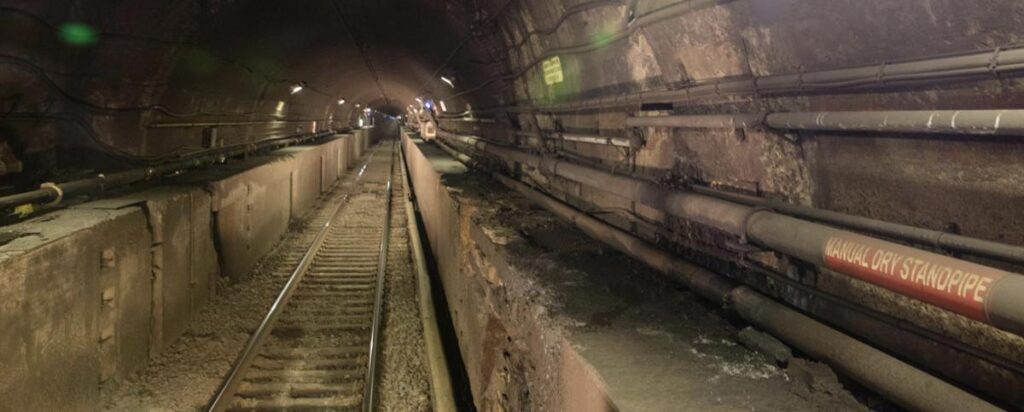Forward momentum continued for the Hudson Tunnel Project during the fourth week of January as the Gateway Development Commission (GDC), which is managing what has been described as the nation’s most critical infrastructure project, announced a major next step.
GDC identified its shortlist of qualified construction teams who will receive an invitation to submit plans in response to a Request for Proposals (RFP) for a design-build contractor to perform final design, construction and other related work for the tunnel on Manhattan’s West Side.
NJBIZ noted Jan. 23 that the trio of joint ventures were among those that submitted a Statement of Qualifications (SOQ) in December in response to a Request for Qualifications (RFQ) issued by GDC.
The teams are:
- FKC-Tutor Perini-Hyundai, a JV comprised of Frontier-Kemper Constructors Inc. and Tutor Perini Corp., both based in Los Angeles, and Hyundai America Inc., another California company.
- Gateway Tunnel Partners, made up of Halmar International LLC in Nanuet, N.Y., and FCC Construction Inc., headquartered in Caledonia, Mich.
- Skanska/Traylor/Walsh JV, a partnership of Skanska USA Civil Northeast Inc., with offices in Queens, N.Y., Traylor Bros. Inc., based in Evansville, Ind., and Walsh Construction II LLC in Concord, Calif.
The Hudson Tunnel Project has three major components, according to the GDC:
- A new, two-track Hudson River rail tunnel will be constructed between the Bergen Palisades in New Jersey to Manhattan.
- A third and final rail right-of-way preservation section will be built underneath Hudson Yards in New York City. This will eventually allow trains to travel between the new Hudson River Tunnel and Penn Station on 8th Avenue between West 31st and West 33rd streets.
- The existing North River Tunnel beneath the Hudson River, which has suboptimal service reliability and an antiquated design, was severely damaged during Superstorm Sandy in 2012, and needs to be rehabilitated.
These three components will improve reliability, resiliency, and redundancy for hundreds of thousands of daily passengers who travel across the Hudson River and allow for much-needed repairs on an essential stretch of the Northeast Corridor.
Upon completion of the Hudson Tunnel Project, four tracks (two in the new Hudson River Tunnel and two in the North River Tunnel) will be available between New Jersey and New York under the Hudson River and allow for operational flexibility and redundancy for Amtrak and NJ TRANSIT rail operations to maintain current capacity levels.
Winning Joint Venture Likely to Begin Work in 2024
NJBIZ learned that construction on the Hudson Tunnel project is expected to get under way later this year and continue through mid- to late 2029.
When that occurs, the first phase of the effort will include two parallel tunnels extending from just west of Manhattan Bulkhead, below 12th Avenue and to the 12th Avenue shaft. In addition, the proposal also calls for a second pair of parallel tunnels running from the that tunnel shaft to the Hudson Yards concrete casing below 30th Street.
According to the GDC, the tunnel will then continue through the foundation of the Manhattan bulkhead below the river bottom and continue about 45 ft. below the surface and underneath Hudson River Park and 12th Avenue, beneath the block between West 29th and West 30th streets on the west side of 12th Avenue, and beneath West 30th Street.
On the north side of West 30th Street, the alignment meets the concrete casing, before continuing beneath 10th Avenue to a tunnel portal to the east, before finally connecting to Penn Station.
New Tunnel Critical to Region’s Vibrancy
By constructing the Hudson Tunnel Project, rail users also will be provided with a resilient regional and national rail network, and in doing so, substantial social, economic and environmental benefits will come to the New York-New Jersey metropolitan area. They will likely include:
- The elimination of a single point-of-failure for a region whose economy drives a sizable portion of America’s gross domestic product (GDP). Indeed, the New York regional economy and the Northeast corridor mega-region contribute 10 percent and 20 percent, respectively, to the nation’s GDP.
- Over 72,000 direct, indirect and induced jobs in the region will be created during the tunnel project’s construction period.
- A stimulation of the local economy will bring about the generation of $19 billion in economic activity over the life of the job.
- Utilizing U.S. suppliers and manufacturers through the Buy America requirement that applies to federally funded purchases as well as the federal provisions regarding participation by disadvantaged businesses.
- Cutting back on greenhouse gas emissions on already overcrowded roads by making train use more attractive and dependable. Without the Hudson Tunnel Project, North River Tunnel repairs would cause 2 million additional tons of carbon to be released into the atmosphere. This is the equivalent of flying 2.6 million people from New York to San Francisco.
- Providing long-term climate resiliency. As the planet gets warmer and the weather more unpredictable, it is important that America’s rail infrastructure is built accordingly. The Hudson Tunnel Project will provide long-term resiliency, reliability, and redundancy to mitigate extreme weather events.
This latest development builds on other previous ones, which NJBIZ reported on, such as the start of construction on both the New Jersey and New York sides of the Hudson River as well as a recap of 2023 and a look at what is in store for the project in 2024 from GDC Chief Executive Officer Kris Kolluri.
“All of us at GDC are working day in, day out to keep the momentum going on this project,” he told NJBIZ. “We are thrilled to have a strong slate of shortlisted firms who will bring that energy to this critical and challenging phase of work on the Hudson Tunnel Project.”
Read the full article here











